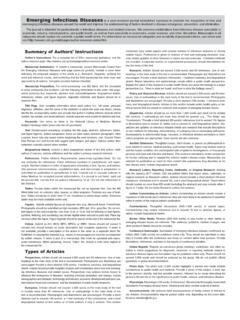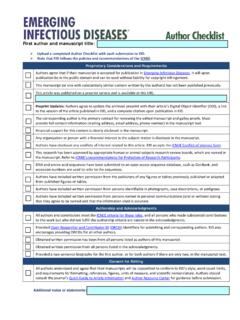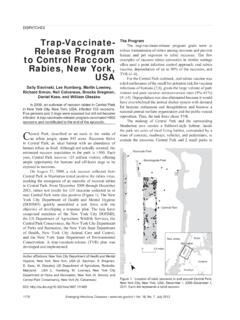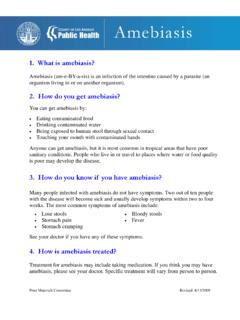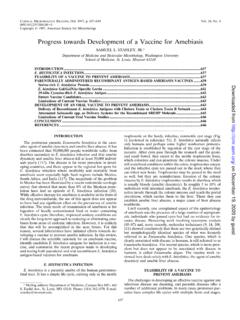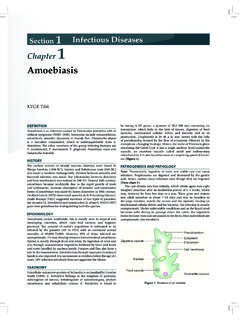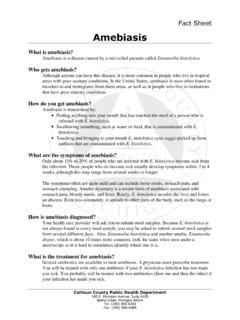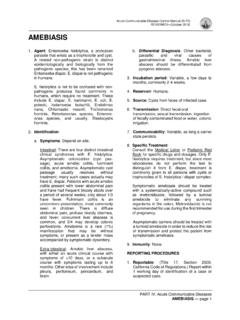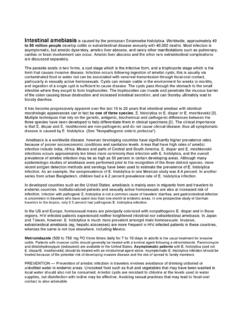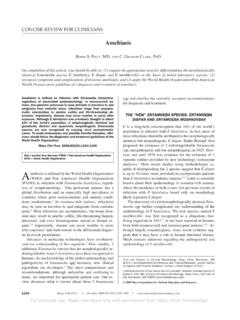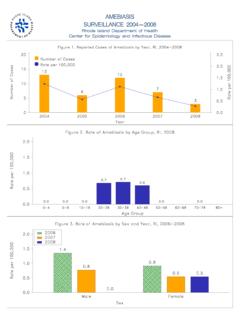Transcription of Invasive Amebiasis in Men Who Have Sex with Men, Australia
1 Invasive Amebiasis in Men Who have Sex with Men, AustraliaDamien Stark,* Sebastian J. van Hal,* Gail Matthews, John Harkness,* and Deborah Marriott*Entamoeba histolytica is a pathogenic ameba that has recently been recognized as an emerging pathogen in men who have sex with men (MSM) in Asia-Pacifi c countries where it is not endemic, , Japan, Taiwan, and Republic of Korea. We report locally acquired Invasive Amebiasis in Sydney, Australia , exclusively in histolytica is a pathogenic ameba that can cause Invasive intestinal and extra-intestinal disease. The most frequent manifestations of Invasive Amebiasis are colitis and liver abscesses (1). Although E. histolytica is one of the most common parasitic infections worldwide, Invasive disease remains uncommon in industrialized counties.
2 Re-cent studies from Japan, Taiwan, and Republic of Korea, ar-eas where E. histolytica endemicity is generally low, suggest that Amebiasis is an emerging parasitic infection that occurs exclusively in men who have sex with men (MSM) (2 6). In Australia , the documented incidence of Entamoeba spp. in the general population is 1% 4% (1). In MSM, the rates of Entamoeba spp. carriage were previously documented to be as high as 37% (7). However, these studies failed to dif-ferentiate the pathogenic E. histolytica from the morphologi-cally identical nonpathogenic E. moshkovskii and E. dispar, therefore leaving the accuracy of these results in question. A study in Australia that used molecular methods showed E. histolytica prevalence rates in MSM to be as low as (8). Impaired host immunity is associated with increased pathogenicity of Invasive Amebiasis .
3 Recent studies indicate an increased risk for Invasive Amebiasis among persons with HIV (9,10). We report 5 cases of Invasive Amebiasis in MSM from Sydney, New South Wales, Australia , from December 2006 through October 2007. The CasesOf the 5 patients, 3 had amebic colitis and 2 had amebic liver abscesses, all were MSM, 4 were HIV-infected, mean age was 45 years (range 35 57 years), and median CD4 count was 713 cells/mm3 (Table). No associations among any of the patients were noted. All patients were receiving highly active antiretroviral therapy at the time of examina-tion. Of the 5 patients, 4 had not traveled extensively in the past 4 years, but the remaining patient had traveled to Malaysia and China 6 months before onset of colitis. Other possible risk factors for acquisition were identifi ed in 4 pa-tients: 3 had had high-risk sex behavior at sex-on-premises venues, and the other had had a male partner who had trav-eled to countries where Invasive Amebiasis was highly patients had bloody diarrhea and abdominal pain for 2 4 weeks.
4 Routine fecal cultures were negative for bacterial pathogens. Microscopic examination of per-manently fi xed, stained fecal smears was positive for E. histolytica/dispar/moshkovskii complex. Diagnosis of E. histolytica was confi rmed by PCR targeting the small sub-unit ribosomal DNA as described (8). Results of serologic examination of these patients were positive; all titers were >256 according to indirect hemagglutination antibody as-say, which confi rmed Invasive disease. However, although antibodies against amebae indicate Invasive disease, these antibodies can also be seen in persons with asymptomatic colonization with amebae (1). The 2 patients with liver abscesses each had large, soli-tary abscesses in the right lobe of the liver (8 6 6 cm and cm). In 1 patient, the abscess ruptured through the liver capsule, and collapse of the right middle and lower lung lobes and a resultant pleural effusion com-plicated the subphrenic collection of pus from the abscess.
5 Levels of liver enzymes (alkaline phosphatase and gamma glutamyl transferase), C-reactive protein, and neutrophils (absolute numbers) were raised. Both patients underwent percutaneous drainage of their liver abscess; cultures of as-pirated pus were negative for bacteria and fungi. Results of indirect hemagglutination antibody assay were positive; titer was >256. Microscopy and PCR of fecal samples were negative for E. histolytica. For these 2 patients with ame-bic liver abscess, the diagnosis was delayed; they had had symptoms for >2 weeks and were then treated for bacterial liver abscess before the correct diagnosis was made. All 5 patients made a successful recovery after treat-ment with metronidazole. In addition, all were treated for cyst carriage with paromomycin, a luminal histolytica carriage and Invasive disease are com-mon in the Asia-Pacifi c region, especially in developing countries.
6 In countries where E. histolytica prevalence is low, such as Japan, Taiwan, Republic of Korea, and Aus-tralia, rates of Amebiasis are low and Invasive Amebiasis is uncommon. Recent reports from a number of these coun- Emerging Infectious Diseases Vol. 14, No. 7, July 2008 1141 *St. Vincent s Hospital, Darlinghurst, New South Wales, Australia ; and University of New South Wales, Sydney, New South Wales, AustraliaDOI: , however, suggest that Invasive Amebiasis is emerg-ing as an increasingly common infection, specifi cally in the MSM population (2 6). MSM have a higher risk than others for intestinal parasite carriage; not only are they sub-stantially more likely to harbor intestinal protozoa, but they are also more likely to harbor multiple parasites (11). These protozoa are transmitted by the fecal oral route; high rates of oral anal sex by MSM are considered the reason for increased rates of carriage.
7 Because E. histolytica is also transmitted by the fecal oral route, MSM may also have an increased risk for E. histolytica carriage. This higher rate of asymptomatic carriage is likely to translate into a greater risk for Invasive disease. Recent seroprevalence studies in Taiwan that used indirect hemagglutination antibody assay have confi rmed MSM s statistically signifi cant higher risk for E. histolytica exposure (5).In Japan, Amebiasis has become endemic in MSM; symptomatic E. histolytica infection occurs almost exclu-sively in middle-aged MSM in the large cities of Japan (2,3). Similar fi ndings are reported for MSM in Taiwan (4,5). More recently, a study from the Republic of Korea documented Invasive Amebiasis (amebic liver abscess) in HIV-infected MSM (6).
8 To date, the emergence of E. histolytica infections in MSM seems to be limited to the Asia-Pacifi c region. In a large retrospective study of 34,000 HIV-infected patients in United States, only 2 pa-tients had Invasive Amebiasis (12). The reasons for this geographic variation are unclear, but it is likely linked to the higher background prevalence of E. histolytica infec-tions in Asia. Regional E. histolytica strains show a high degree of diversity but no major differences between re-gional genotypes; other factors relating to host or virulence factors may be important but are as yet undetermined (3). We now report local acquisition of E. histolytica by MSM in Australia ; as shown by the above 5 cases of Invasive disease and 3 previous cases of noninvasive infections also acquired locally (13).
9 Of note, 4 of the 5 patients we report were HIV in-fected. Seroprevalence rates of E. histolytica (determined by indirect hemagglutination antibody assay) are higher for HIV-infected persons then for HIV-nonninfected persons, although the reasons are unclear (5,14). Higher rates of E. histolytica carriage in MSM likely refl ect high-risk sex be-havior and multiple exposures, resulting in increased risk for acquisition. This hypothesis is supported by the high rates of sexually transmitted infections that occur in Aus-tralian MSM who visit sex-on-premises venues (15). Anti-body responses predominantly occur with Invasive disease. Whether immunosuppression caused by HIV infection at-tenuates the risk for Invasive Amebiasis is unknown. His-torically, the evidence has been contradictory, and most published studies had had severe limitations.
10 Nevertheless, more recent data seem to indicate that HIV-infected per-sons are at increased risk for Invasive Amebiasis (9,10).The emergence of E. histolytica in MSM is of public health concern because it has the potential to become en-demic in this population in Australia and to cause severe disease. Further study is needed to identify the reasons for the geographic variation and the role of E. histolytica in Invasive disease. In conclusion, Invasive Amebiasis has the potential to emerge as an important parasitic infection in the Asia-Pacifi c region, especially in HIV-infected MSM in countries where E. histolytica is not Stark is a senior hospital scientist at St. Vincent s Hospi-tal, Darlinghurst. His research interests are directed at molecular diagnosis of parasitic 1.

